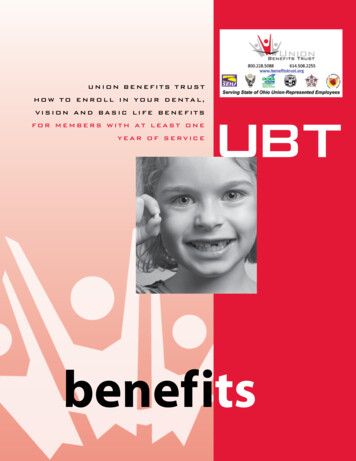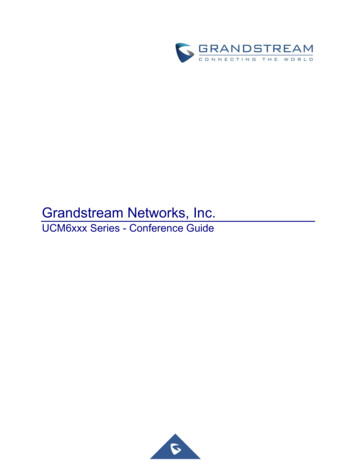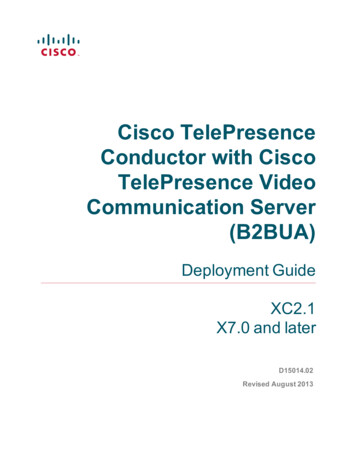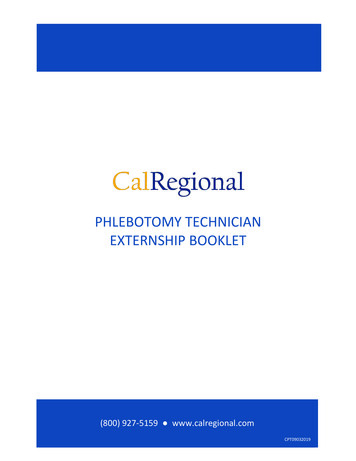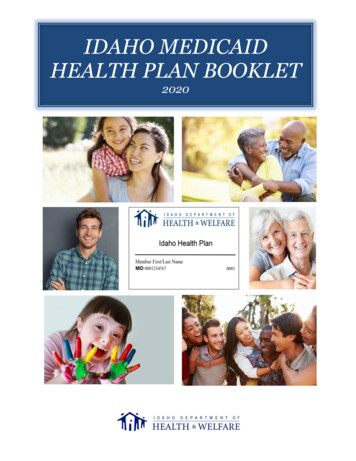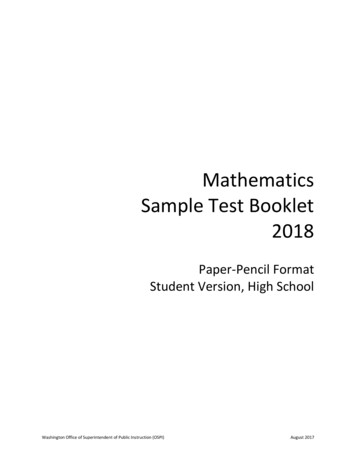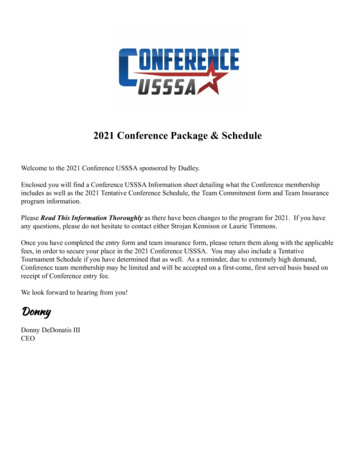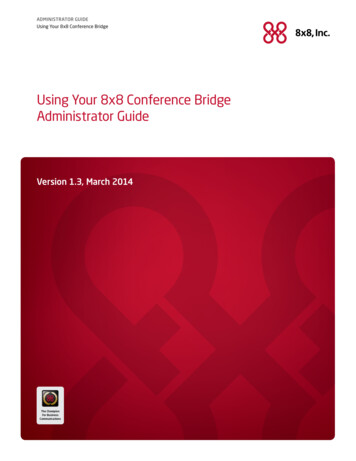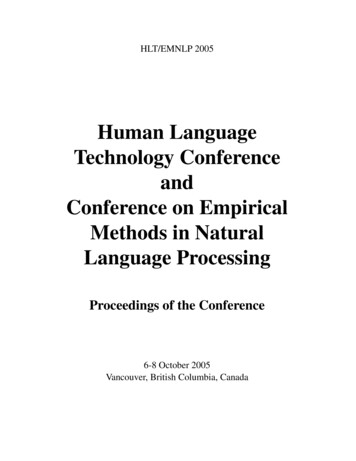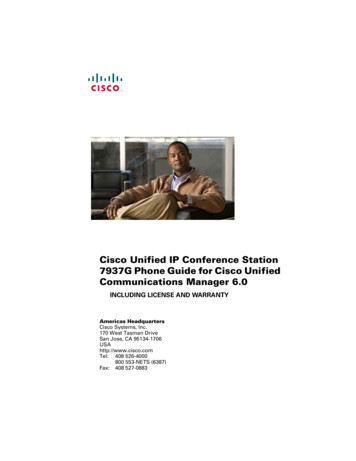
Transcription
!!!!!!!!Conference Program Booklet
Parking InformationVCTM conference attendees can park in the C10 and C12 Lots on JMU’s east campusbetween the hours of 7:30 AM and 8:00 PM on March 13th - 15th, 2014. No parkingpermits will be necessary. Parking in other lots may result in campus guests receivingparking citations. An online campus map can be accessed athttp://web.jmu.edu/parking/parkingmap.pdf .Campus guests are prohibited from parking in specialty spaces such as Service Vehiclespaces, handicap spaces without proper permit, or expired meters. They are alsoprohibited from parking in Fire s!Dining!Hall)!!from!6:30!–!8:30!pm.!!
1C01Elev#11J0110071205Capacity 50CLASSROOMCLASSROOM1M061204Capacity Neural Bases ofCommunicationand SwallowingCapacity 55CLASSROOM1209Capacity 30See1C08ThorneCBnAsoerAnd1M02Group Treatment RoomCapacity 141117ElectrophysiologyResearch Lab1M01Telcom11141115Wymer1206 CLASSROOM1203CHBSCapacity 36CLASSROOMCLASSROOMCapacity 221202Copy 011C071S021T01Prep Lab1007B1C0311111101HHS FIRST estWork Room1130Rout1129O’Donoghue1127 1128Capacity 60CLASSROOM1210Capacity 40CLASSROOM12081G01Video Analysis Lab1026Hearing AidResearch Lab1024PsychoacousticResearch Lab10181G031G021G04Grad StudentsAudiologyApplied Lab10191G0510151120SensorineuralEngineering LabLongerbeam1016DuddingAudiologyResearch 1123 112411321133Drulia/Weaver1134MaterialsScience Lab1031EngineeringScience 3 Operations Center1M03Telcom1M041135Ear &HearingJacobsonGray11371136Reed11381C05Elev#2Cap 1261301CALL1056InfantToddlerLang 45Cap ce Lab1S0511441140 1142LudlowCognitiveAuditoryRes Lab1C04Yoder/BavisterElectrophysiologyApplied Lab115211511139StutteringResearch Lab1J02130311411143StutteringResearch Lab11541153DePaolisClinical ResNeurogenicComm DisPavelko1113Kuo11081150PhDCARRIER DRIVE1149
2109Men2206VendingHHS SECOND FLOORCapacity 48CLASSROOMCLASSROOMCapacity 4022042203CLASSROOM2209Capacity 552M05Capacity 25Capacity 32Capacity s LabCLASSROOM2003SophomoreEngineeringDesign Lab2002EngineeringElev#12J012T02Capacity 142117ControlCLASSROOM2210Capacity 40CLASSROOM22082G012018AHealthAssessment Lab20182018Video21202C02Altman21252016 20172121Kitchen/Mail Room2122BodleDunsmoreReynolds2123 2124Rigney21262G022G04FreshmanEngineering Lab20212G05GraduateReadingRoom2020Work Room21302129McGuire2127 21282G032019HartmanCapacity 602C072M02Conference 2072C062S022S01Women tRoom21402C042037COMPUTERLAB (MAC)2T04Men2302Capacity 3222S052J022C082T03 WomenCapacity 33Elev#22C05AUDITORIUM2G06FreshmanEngineeringLab Prep2039Clean Room2036Clean 4321512150Harper2S06BurtCARRIER DRIVE2149
31063S013101Padgett E F3C0532153217Newbold Coffman3208Capacity 103204Conference RoomKitchen32193M05Boyer3203ACHBSHome AssessmentSuiteElev#13T023J01Coffman C CHBS B LovellTacy3210Men3102Lab DOpsKanclerHHS THIRD 205MailFerenbaughMaiewskiHendrickson31003C03Women leyPotgieterBortolot3105Lipscomb31123113D. Applied lasPaterson32293228J. 0093123Kitchen/Mail ronmentalSystems ResearchPA Classroom3003Anatomy3008Capacity 143119Conference RoomWork orkRoom32223118WilsonYun3223WalterHolland3116R. 531223115Prins3130Frye3G033G04Engineering Lab30193020Engineering LabEngineeringScience Lab3C02Work Room31323131Michalik30103129Lewis3133J. 1Rittenhouse3140Lohr3C0430223T04Men3T03 Women3145c it y 3Capa222301 AUDITORIUM3S053J023C08Elev#2Networking &WirelessISAT/Telecom LabKilkenny3144Theimer3143AS.A.Work Room1-Yr nyeart 147PeacheyWessel31463151SheetsCARRIER DRIVE3150KoslowPeterson3128
CARRIER DRIVEISAT/CS BUILDINGFIRST FLOOR121122123 125 126 Prep Room131Infrared Development andThermal Testing Lab es109ClassroomBieseckerWomen108Benzing107Capacity 90138142Pappas105JaleelUnix EngineeringLabOperatingSystemsLabM103TO HHSAtriumCapacity uringLab142M161 161159146Product Development Lab150151ClassroomCapacity 40Capacity 170ARA#6EgekwuRaabDeaton157156155ManufacturingPrep RoomChenVending153 152
CARRIER DRIVEISAT/CS BUILDINGSECOND FLOOR221222223 225 226 ent Prep Lab231Forensics Lab218Tjaden230Server nMayfield207Aboutabl205Capacity 80242Kirkpatrick240Analytical Chemistry LabT206EnvironmentLabM204243M203CLASSROOMCapacity 36TO HHSElevM268265259nTelosRoomCISE Mail/Work ComputerScienceGA’sBarnes262250COMPUTER LAB266RutherfordGriffithCapacity 75ARA#7M256261267248LINUXCOMPUTER edoGrove257255253252
CARRIER DRIVEISAT/CS BUILDINGTHIRD Stockwell330Biotechnology Prep Room331Radocha316ARA#5Work Room318McGrawEl-Tawab324Rittenhouse317326 ard312Hendrickson336COMPUTER 37308IKM vell372LoveStoloff362373KuhnConference lett360375365VP, RPS (Vacant)Delp364359EvickRohlfOvertonPhysical ScienceandEnergy Lab350CLASSROOMCapacity 48M356Westfall376377346Capacity UTER LABM363Storage371340M304Roof Top GardenandPatio370IKM 57355353ShifflettCapaccio352
Friday Sessions Starting at 8:30 a.m.Session 18:30–9:45ISAT 1489–14Mathematical Expeditions in Polar ScienceThere are multidisciplinary challenges facing our planet, and polar science provides / particularly interesting contextsto engage students. We will examine three mathematics lessons based on / shrinking Arctic sea ice extent, meltingglaciers, and accurately measuring Weddell seals. Lynn Foshee Reed, lynn.foshee.reed@gmail.com, Einstein Educator FellowSession 28:30–9:45ISAT 150PreK–12Game-ificationHaving a hard time getting your students to work in the classroom? Try this one, simple way to engage all yourstudents in the task at hand. Teachers of all grades can transform a boring worksheet into a fun, interactive, activitythat gets students talking about math! The best part? It works over and over and over again. Levi Jaynes, ljaynes@kqps.net, Central High School, King and Queen County PS, VASession 38:30–9:45ISAT 236PreK–5Exploring Mathematical Concepts in a Blended Learning EnvironmentThrough this engaging session, participants will learn a framework for blended learning techniques that can helpstudents learn and process simple to complex mathematical concepts. For example, teachers will combine plushtoys, books, posters, and iPad apps for individual or groups of students to assist their preferred learning method. Rebecca Klemm, rebecca@numbersalive.org, Numbers Alive!Jose Lara, jose@numbersalive.org, Numbers Alive!Session 48:30–9:45ISAT 2432–4Increase Student Engagement and Understanding: Implement I-STEM Design Challenges In YourMath ClassThis hands-on session will walk participants through the steps of the design process using I-STEM (IntegratedScience Technology Engineering & Mathematics). Small groups will plan a solution to the mathematically baseddesign challenge, create a model with the available materials, test their model, and re-design it. Participants willreceive additional ready-to-use I-STEM challenges. Jackie Gulino, jgulino@harrisonburg.k12.va.us, Keister ES, Harrisonburg City PS, VAPaige Rogers, progers@harrisonburg.k12.va.us, Stone Spring ES, Harrisonburg City PS, VASession 58:30–9:45ISAT 3483–8Increasing Engagement with Cooperative LearningTeachers will learn cooperative learning strategies to engage all learners in mathematics. Teachers learn 4 keycooperative learning strategies, and they will leave with activities to support each strategy. Teachers will develop anunderstanding of using cooperative learning with special education and ELL students. Tracy Cabacoy, tmcabacoy@fcps.edu, Springfield Estates ES, Fairfax County PS, VARebecca Cousins, rmcousins@fcps.edu, Springfield Estates ES, Fairfax County PS, VA
Session 68:30–9:45ISAT 3503–5Using Multiple Division Representations: When do I Keep a Remainder?Participants will examine ways to develop an operation sense of division through the use of multiple representations.Using models and diagrams to represent word problems, partitive and measurement division situations will beexplored. Thinking about division as fractions, remainders will be examined using whole numbers, fractions, anddecimals. Dr. Maria Timmerman, timmermanma@longwood.edu, Longwood University, Farmville, VASession 78:30–9:45ISAT LAB19–12Untapped Opportunities: a Glimpse into the Future of Online EducationWith the new VA graduation requirement, online education is here to stay! Mathematics, being more skill-driven andabstract, offers unique challenges in this developing medium. The solutions emerging to address these challengesare creating exciting opportunities that extend into the traditional classroom. Mohammad Edris Qarghah, Mohammad.Qarghah@acps.k12.va.us, T. C. Williams Satellite Campus, AlexandriaCity PS, VASession 88:30–9:45HHS 1202PreK–8Math%is%Everywhere%"If you love sports, you love math", well that is what we believe to be true at the Virginia Sports Hall of Fame & Museum. You can find math everywhere in sports, from the dimensions of a court or field to the probability a kicker will make the 53Eyard field goal. Let us show you how to excited and engage your students with such a likeable topic. Elaina Trafny, trafnye@vshfm.com, Virginia Sports Hall of Fame and Museum, Portsmouth, VASession 98:30–9:45HHS 12036–12Engaging 6-12 Mathematics Students with Inquiry-Based TeachingResearch suggests that teaching through hands-on/minds-on, inquiry-based instruction engages students andenhances the students’ conceptual understanding. How do we do this in a secondary (6-12) math classroom?Participants will be provided with varied inquiry-based lessons that can be used in the teaching of mathematics ingrades 6-12. Linda Pond, lpond@odu.edu, Old Dominion University, Norfolk, VAKelly S. Clark, ksclark@odu.edu, Old Dominion University, Norfolk, VASession 108:30–9:45HHS 12049–16 , RPromoting Students’ Understanding of the Role of Mathematical ProofThe session will consist of two parts. In the first part, results from an exploratory study that evaluated secondaryschool students’ perception of mathematical arguments will be shared. During the second part, interventions thatcould potentially promote students’ understanding of the role of proof via the use of counterexamples will bediscussed. Yating Liu, y1liu@odu.edu, Old Dominion University, Norfolk, VA
Session 118:30–9:45HHS 12079–12Computer Math: Relevant mathematics for vocation-minded studentsSession will provide information on a course sequence that includes the VDOE approved course Computer Math asimplemented by one school division in Virginia. The presenter will provide examples of projects from the course,specifically designed to address real-world mathematical concepts. Chris Noll, cnoll@rockingham.k12.va.us, Turner Ashby HS, Rockingham County PS, VASession 128:30–9:45HHS 12086–8Algebra Tiles: Representing the Big IdeasVisualizing major concepts in algebra aids in understanding. Participants will be actively involved with algebra tilesfor working with operations and algebraic expressions, factoring, solving equations and inequalities, and playinggames for reinforcing the big ideas. Materials will be provided. Don S. Balka, donbalka@sprintmail.com, St. Mary’s College, Notre Dame, INSession 138:30–9:45ISAT 1483–5The Importance of the Elementary Principal in Mathematics InstructionAn Elementary Principal who is also a K-8 Mathematics Specialist shares a little bit of what he has learned aboutleadership and math instruction. This will provide a brief overview of what is important for elementary principals toknow about mathematics in the classroom--from proper math vocabulary to appropriate conceptual instruction &more. Rod Gillespie, rodgillespie@wvva.net, Abbs Valley-Boissevain ES & Springwood ES, Tazewell County PS, VASession 148:30–9:45HHS 13013–12Introducing Algebra-From Properties of Real Numbers to Linear Equations in Slope-InterceptFormEach attendee will receive a set of A Tiles and a 100 Board. This is a "Hands-On" presentation with a promise tointroduce you to a number of activities that engage students from 3rd to 9th grades in acquiring essential algebraskills! Art Stoner, agstoner@att.net, A CompassSession 158:30–9:45HHS 2031AllReasoning and Making Sense in Teaching and Learning Mathematics, the Most ImportantStandard!Too often mathematics instruction focuses on procedural knowledge. Teaching with a lens on helping students tomake sense of the mathematics they are learning ensures deeper understanding. Let's look at what it takes totransform our instruction from "show and tell" to "now I get it!!" Linda Gojak, President, National Council of Teachers of MathematicsSession 168:30–9:45HHS 22023–5Division Beyond "Gosinta"This workshop will look at building division concepts and the need to go beyond how many times the divisor "goesinto" the dividend. Participants will gain experience with activities they can then use in their own classrooms. Terri Okes, tbokes@henrico.k12.va.us, Henrico County PS, VADebi Godfrey, dmgodfre@henrico.k12.va.us, Henrico County PS, VA
Session 178:30–9:45HHS 2203PreK–5Attacking Word Problems with Comprehension and Computation StrategiesWant to learn how comprehension and computation strategies build students' conceptual knowledge and confidencein solving word problems? You will leave this session with a variety of classroom activities that actively involvestudents in attacking problems and using mental computation strategies to solve single and multiple step wordproblems. Sharon Welch Person, mathonthebrain@gmail.com, John Tyler ES, Portsmouth PS, VAGwen Best, ilovechalkdust@gmail.com, Franklin PS, VASession 188:30–9:45HHS 22049–12Using Beads to Illustrate the Central Limit TheoremUnderstanding sampling distributions of sample means and sample proportions is one of the most challenging topicsfor AP Statistics students. Students also tend to confuse the two. Using beads, we will experience numeroussampling iterations of differing sample sizes. Our resultant graphs will illustrate the CLT in ways students findmemorable. Mimi Corcoran, mcorcoran@highlandschool.org, Highland School, Warrenton, VASession 198:30–9:45HHS 22086–12Math Lab in High SchoolFollow the progression of extra help for high school students in all levels of mathematics at a high school of 1300students. We will share our successes and failures and hopes for the future. Shelly Pine, pines@frederick.k12.va.us, James Wood HS, Frederick County PS, VAMindy Booth, boothm@frederick.k12.va.us, James Wood HS, Frederick County PS, VAAllison Tait, taita@frederick.k12.va.us, Frederick County PS, VAMelissa Charles, charlesm@frederick.k12.va.us, Frederick County PS, VASession 208:30–9:45HHS 22099–12The NASA LEARN Program: Longterm Engagement in Authentic Research with NASAThe NASA LEARN Project is an innovative program that provides educators with on-site research and training withNASA scientists in the summer and guided research projects that continue throughout the school year. Educatorsconduct their own research with help of a team of NASA scientists and share/integrate these projects into theirclassrooms. Tim Kubinak, timothykubinak@spsk12.net, John Yeates MS, Suffolk County PS, VASession 218:30–9:45HHS 2210RAction Research in the Elementary School ClassroomThis presentation describes the results of three action research projects by graduate students at the University ofMary Washington. The research involved the effects of employing Math Buddies in grades K and 5; integratingSTEAM projects into a first-grade class; and implementing Whole Brain activities in a kindergarten class. Maria P. Sheckels, msheckel@umw.edu, University of Mary Washington, Fredericksburg, VAElizabeth Butler, ebutler2@umw.edu, University of Mary Washington, Fredericksburg, VATaylor Chadman, tchadman@umw.edu, University of Mary Washington, Fredericksburg, VAClaire Gianelle, cgianell@umw.edu, University of Mary Washington, Fredericksburg, VA
Friday Sessions Starting at 10:00 a.m.Session 2210:00–11:15ISAT 1366–8Investigating Surface Area & Volume in the Middle School ClassroomThe purpose of this presentation is to take a deeper look as to why students struggle with Surface Area and Volume.We will be looking at the State's 2012 Performance Analysis questions on Surface Area & Volume. The participants ofthis presentation will be provided with several activities, strategies, and resources to help with their instruction. Patty McGraw, mcgrawpa@pwcs.edu, Beville MS, Prince William County PS, VASession 2310:00–11:15ISAT 1483–5Building Links Between Multiplication and Division: Concepts and SkillsMultiplication and division are closely linked. This session will demonstrate strategies that can be used to reinforcethe connection between these operations and to develop flexible thinking. In particular the session will show practicalways to develop the concepts and skills for both operations through the use of visual models and games. Debi DePaul, d depaul@origomath.com, ORIGO Education, Inc.Session 2410:00–11:15ISAT 1509–12Back-To-Back Learning - Circling Back By Design to Check for Understanding.A collection of tested ideas and strategies used in the Algebra 1 and 2 classroom to continuously monitor studentunderstanding throughout the entire lesson. Linda Johnson, linda.a.johnson1@gmail.com, McLean High School, Fairfax County PS, VASession 2510:00–11:15ISAT 2433–5Number Talks and Order of OperationsNumber Talks support children building mental math and computation strategies. Through number talks, studentsmake sense of the mathematics that they are presented. Participants experience number talks and leave ready tolead a number talk. Molly Rawding, mmrawding@fcps.edu, Annandale Terrace ES, Fairfax County PS, VASession 2610:00–11:15ISAT 2596–8How can you subtract a negative number?Using two-color counters, number lines, and other models, we will work on integer addition and subtraction tasks inwhich we think about subtraction as completion and think about integers as directed differences. We’ll discuss howthese tasks can help students make sense of integer multiplication and division and ease the transition to algebra. Catherine Ulrich, culrich@vt.edu, Virginia Polytechnic Institute and State University, Blacksburg, VASession 2710:00–11:15ISAT 348PreK–5Making Sense of Word ProblemsParticipants will gain an understanding of a problem solving process called UPSC (Understand, Plan, Solve, Check)and will discuss samples of students' work using the process. The presenters will share strategies for helpingstudents to make sense of word problems and will discuss why using "key word" strategies should be avoided. Donna Stofko, stofkoda@pwcs.edu, Prince William County Public Schools, VA
Session 2810:00–11:15ISAT 3509–12Can we use our phones? Using mobile technology in the math classroom.We live in an age where almost every student (and most teachers) have access to a device just as powerful (if notmore powerful) than the laptops we get issued by our counties. In this session, we will be exploring some apps touse with both Android and iOS devices, and also discussing strategies in implementing these technologies. Matthew Sherman, msherman@bshknights.org, Blessed Sacrament Huguenot School, Henrico, VASession 2910:00–11:15ISAT LAB19–12Using Modeling and Simulation in Your Algebra ClassesCreate simulation-based STEM lessons to take back to your classroom. Increase your resources for lessonsinvolving Algebra concepts. Yvonne Wampler, ywampler@nortoncityschools.org, J. I. Burton HS, Norton City PS, VASession 3010:00–11:15ISAT LAB 2PreK–12Numbers Bee: Improving Fluency with Numbers and Operations for all ages.Numbers Bee is an online math game for elementary and middle school students designed to promote numeracy andbuild confidence in their math skills through interactive learning and competition among peers. It increases criticalthinking skills. It is a fun teaching tool and can be used every day in the classroom and in afterschool clubs Dr. Sakthi Vel, vel@NumbersBee.com, NumbersBee.comShirley Ellison, sfellison@redclay.k12.de.us, Red Clay Consolidated School District, DESession 3110:00–11:15HHS 12026–8Using Daily Routines to Build Number Sense of Middle School StudentsHow many middle school students have good number sense or proportional reasoning skills? Come learn some dailymath routines that can help students become more comfortable working with rational numbers. In this interactivesession, participants will leave with ideas, activities and resources to use in their classrooms tomorrow. Catherine Schaefer, catherine.schaefer@vbschools.com, Windsor Woods ES, Virginia Beach City PS, VAAlison Moir, amoir@hampton.k12.va.us, Hampton City PS, VAReginia Harris, rharris@hampton.k12.va.us, Hampton City PS, VASession 3210:00–11:15HHS 12039–12What's a Radian, Anyway?Knowing Unit Circle values is a critical skill in Trigonometry, Math Analysis, Calculus, and beyond. But how much dostudents remember when asked to write them, fill in the blanks and memorize? This session will give you a hands-ondiscovery method for teaching unit circle values while connecting them to prior knowledge of Geometry. Diane Briggs, dbriggs@cgs.k12.va.us, Colonial Forge School/Commonwealth Governor’s School, VASherri Oesterheld, soesterheld@cgs.k12.va.us, Riverbend HS/Commonwealth Governor’s School, VASession 3310:00–11:15HHS 1204PreK–8Contemplating Coaching Decisions: Cases from a Math Specialist’s PracticeIn addition to focusing on the practice of classroom teachers, math specialists need opportunities to discuss their ownpractice as well. In this session, cases will be shared from a middle school math coach and participants will analyzethe decisions that math coaches make and discuss coaching moves that can support the work of teachers. Cindy Cooper, coopercl@pwcs.edu, Godwin MS, Prince William County PS, VA
Session 3410:00–11:15HHS 12079–12Square Roots Using a Carpenter's SquareBefore there were calculators, carpenters often times needed to know a square root measurement before cutting.Skilled carpenters could approximate the calculation with the use of a carpenter’s square. This brief presentationdemonstrates how they do it. Joe Joyner, jjoyner@tcc.edu, Tidewater Community College, Virginia Beach, VASession 3510:00–11:15HHS 12096–12Making Mathematics Real: Knot theory, experimental mathematics, and 3D printingFor a pure mathematician, mathematics is a set of abstract constructs completely separated from reality, and usingtechnology to explore mathematics can seem like, well, cheating. But modern technology can help supportexploratory, investigative mathematics, even for those of us that are old-school mathematical purists at heart. Goinga step further, the recently accessible technology of 3D printing can take abstract mathematical objects and literallymake them real. A 3D printing demonstration will accompany this talk. Laura Taalman, laurataalman@gmail.com, James Madison University, Harrisonburg, VASession 3610:00–11:15HHS 1210PreK–8Family Math NightFamily Math Night can be organized at your school without creating additional stress to your busy schedules. Theactivities in this presentation can be adapted to elementary and middle school levels. Participants will receive lots ofideas and actually do some of the activities! Family Math Night can be Family Fun night for all!!! Kathy Judge, judgekm@pwcs.edu, Rippon MS, Prince William County PS, VASession 3710:00–11:15HHS 13019–16Bisquick can kill you and other fun, but WRONG, facts!People often believe “facts” they hear and read, without ever investigating whether these facts are true. Usually aquick Google search or snopes.com can set the record straight. Why are we so gullible? We will examine manynewspaper articles, Facebook entries, and common myths that go viral to see how data is manipulated andmisrepresented. Colleen Watson, watso2ca@jmu.edu, James Madison University, Harrisonburg, VASession 3810:00–11:15HHS2301PreK–16The Importance of Connections and Reasoning in the Mathematics ClassroomFocus on the process skills in mathematics teaching are essential to building student understanding. This sessionwill focus on examples of how teachers can facilitate mathematical connections and reasoning in their classrooms. Michael Bolling, michael.bolling@doe.virginia.gov, Virginia Department of EducationSession 3910:00–11:15HHS 22026–12Hands On Triangle Congruence Exploration and ProofPresenters will model an exploration of triangle congruence through the use of manipulatives. Teachers will walkaway with a structured activity in which students can discover the necessary and sufficient criteria for ensuringtriangle congruence. The activity concludes with a transition into flow proofs and two column proofs. Stephanie Brady, sbrady@hcps.us, Patrick Henry HS, Hanover County PS, VAGretchen Shaw, gshaw@hcps.us, Patrick Henry HS, Hanover County PS, VA
Session 4010:00–11:15HHS 22033–81 to 1 Devices in Math; Year One*Presentation on the use of 1 to 1 laptops in a diverse middle school. / *Examples will include: journaling,Blackboard, flipped classroom, ActivInspire, etc. / *Applications to freeware Peter Fiddner, pfiddner@k12albemarle.org, Jackson P. Burley MS, Albemarle County PS, VASherica Jones-Lewis, sjlewis@k12albemarle.org, Jackson P. Burley MS, Albemarle County PS, VASession 4110:00–11:15HHS 2204PreK–2Developing Number and Operation Concepts with Ten FramesTen frames are one of the most useful K-1 tools for teaching and learning in the primary grades. Participants willexperience games and activities matching Virginia's Standards of Learning for number sense and computation. Helpstudents attach meaning to counting, composing/decomposing numbers, understanding place value, and adding andsubtraction. Ruth Harbin Miles, rharbin@mbc.edu, Mary Baldwin College, Staunton, VADon S. Balka, donbalka@sprintmail.com, St. Mary’s College, Notre Dame, INSession 4210:00–11:15HHS 2208PreK–8Surface Area of a Care Package: A Mathematical STEM LessonLearn how to incorporate science, technology, and engineering into a geometry lesson on finding volume and surfacearea of a rectangular prism, while also conducting a service project. The presenter will demonstrate a lesson usingSTEM components that is hands-on and student driven, while engaging the participants in the lesson. Amy Gordon, amgordon@hcps.us, Pole Green ES, Hanover County PS, VASession 4310:00–11:15HHS 22103–5Multiplication and Division Strategies for Increasing Student UnderstandingDo your students need a deeper understanding of the meaning of multiplication and division? Come learn multiplestrategies to help your students model multiplication and division problems. Participants will learn multiple strategiesto encourage students to use a variety of problem solving techniques with math facts and multi-digit problems. Suzanne Coleman, scoleman2@bedford.k12.va.us, Boonsboro ES, Bedford County PS, VAFriday Sessions Starting at 11:30 a.m.Session 4411:30–12:45ISAT 136PreK–16Writing to Learn and Learning to Write in MathematicsThis interactive presentation will examine the “What”, “Why”, and “How” of incorporating content area writing in themathematics curriculum. We will consider the need for writing in the content areas and examine and practicestrategies to implement writing in mathematics. Marlene Robinson, robinsonmarlenea@gmail.com, International Center for Leadership in Education, AlbemarleCounty PS (retired), VA
Session 4511:30–12:45ISAT 1486–8Developing Probabilistic Thinking: Big Ideas From Unlikely Plac
toys, books, posters, and iPad apps for individual or groups of students to assist their preferred learning method. Rebecca Klemm, rebecca@numbersalive.org, Numbers Alive! Jose Lara, jose@numbersalive.org, Numbers Alive! Session 4 8:30-9:45 ISAT 243 2-4
